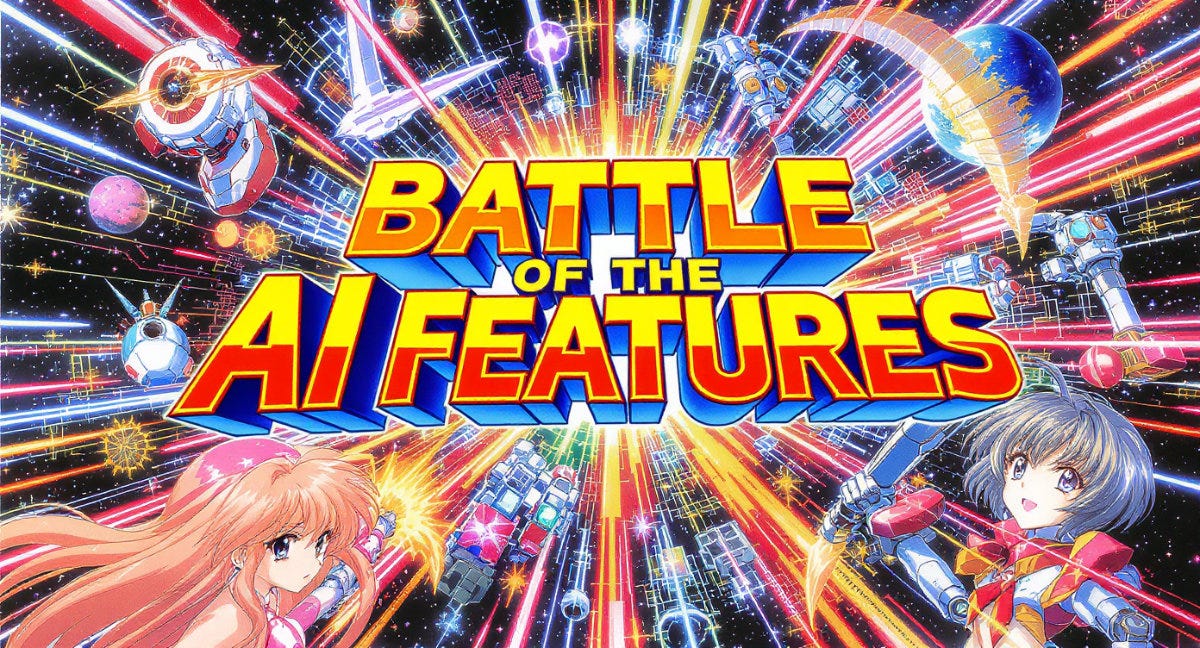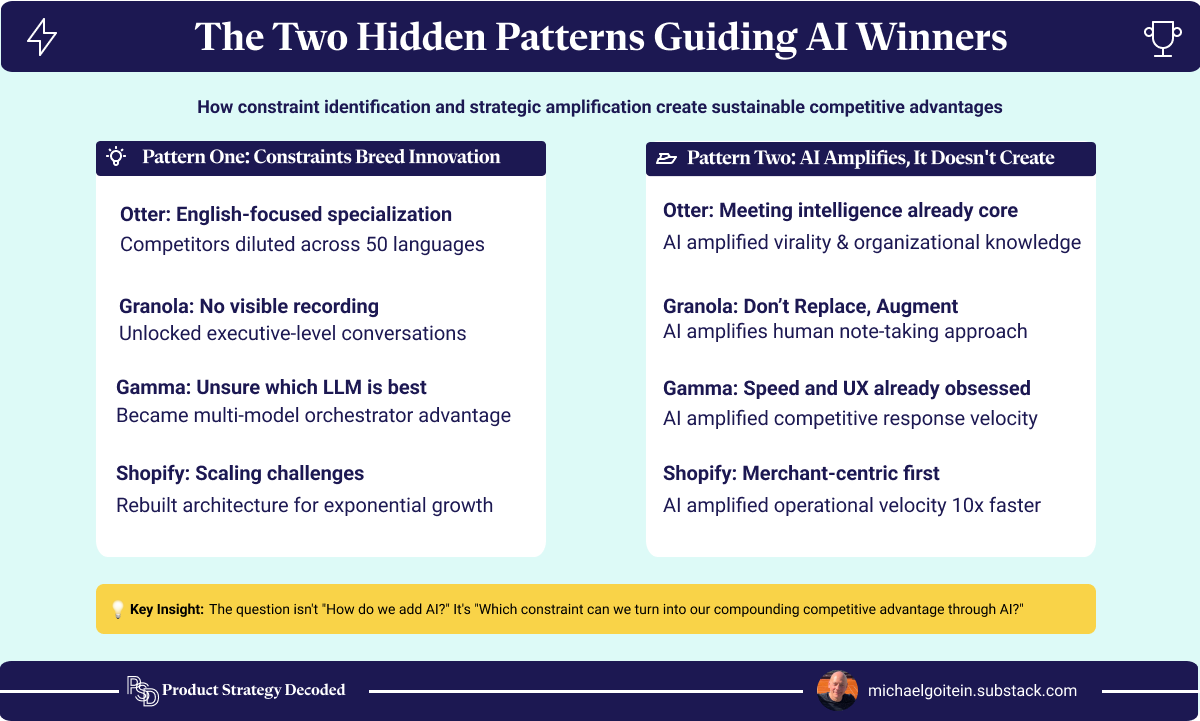Why AI Feature Battles Completely Miss the Real Competitive Advantage
Winners go beyond just adding AI to their products to completely reimagine their product strategies around capabilities AI is just now making possible

Too many companies treat AI like a feature to bolt onto existing products.
They add a copilot here, automate a workflow there, launch an AI-powered tool, and wait for adoption. Six months later, their competitive edge vanishes.
Meanwhile, the billion-dollar AI powerhouses win by playing a different game entirely.
Shopify rebuilt its entire operating model around AI-first process reimagination.
Granola built an entirely new architecture around on-device processing to access markets competitors structurally couldn’t reach.
Otter.ai designed a strategy based on permissionless adoption and compounding organizational knowledge.
And Gamma went from near-bankruptcy to $50M ARR by orchestrating the best of every LLM, enabling speed and performance advantages that locked-in competitors cannot match.
Through the power of AI, all of these foundational strategy architectures compound faster than competitors can copy superficial features.
That’s the hidden competitive advantage that outlasts feature parity.
Winners Ask a Different Question
Most companies approaching AI ask variations of the same questions: “How do we build better AI features than competitors? How do we automate more? How do we match what the other guy is doing?”
Feature parity becomes a commodity within a year. Competitors will copy your capabilities in six months. They’ll outspend you on infrastructure. They’ll hire smarter researchers.
As I’ve said before, the quality of your questions determines the quality of your strategy. Winners ask the kind of power questions that unleash completely different outcomes:
Where are we uniquely suited to deploy AI, given our existing position?
Where does AI unlock a market segment our competitors structurally cannot access?
What constraint can become our advantage through AI?
These questions go a level deeper beyond producing me-too products to produce asymmetric, compounding competitive advantages.
Otter.ai: How Viral Permissionless Adoption Creates Compounding Advantage
Otter.ai decided early to build a proprietary AI stack optimized for real-time transcription and lightning-fast meeting insights that could be shared virally, reaching the whole org.
Traditional Enterprise SaaS requires procurement consensus and top-down adoption of B2B software. How do you drive adoption without permission from everyone above you?
Just like Slack did by making bottom-up adoption so frictionless it spread without requiring IT approval.
The Happy Viral Infection
But that means making your product so easy to use and delightful that one user’s decision automatically creates value for the entire org without needing to request approval.
Otter acts like a “beneficial virus,” “infecting” non-users with free transcripts and takeaways, who suddenly gain significant value regardless whether they were in the meeting or not.
With each meeting touching an average of 7.5 users, the virally spreading, permissionless, bottom-up adoption becomes a compounding distribution engine flywheel.
Otter trained its real-time architecture on 50 billion+ minutes of meetings. Ambient intelligence builds compounding organizational knowledge over time. The longer you use it, the more valuable it becomes, and the harder it is to replace.
Result: Otter.ai has achieved $100 million in Annual Recurring Revenue (“ARR”) with fewer than 200 employees.
Winning Aspiration: Searchable organizational knowledge across all meetings
Where to Play: All professional meetings across industries (true horizontal reach)
How to Win: Permissionless value creation where one user generates value for the entire organization
AI’s Role: Compounding, valuable knowledge asset that strengthens with use
Granola: AI as a Privacy Shield
Granola discovered that every competitor’s core feature became their fatal flaw.
Meeting bots and visible signs of recording remain the industry standard, but have no access to higher-value conversations.
Think of it like bringing a court stenographer to an evening of bourbon, poker, football, and cigars.
As soon as people feel they’re “on the record,” you can kiss those honest, frank conversations goodbye. Players suddenly speak in careful, “safe” language. The fun, relaxed, open exchanges you tried to create evaporate the minute anyone knows it’s “official.”
And this is exactly how visible recording makes people feel in high-stakes executive conversations.
Let The Party Begin
The Granola team’s foundational choice was radical: build meeting intelligence without visible bots, stored audio, or consent overhead.
This involved developing on-device processing, real-time enhancement of human-written notes, and preserving the cognitive benefits of active note-taking while enhancing them with AI intelligence.
Granola’s AI guides insights into organizational memory while deleting the recording. Add SOC 2 Type 2 compliance, and suddenly, markets opened that competitors couldn’t reach by building “better meeting bots.”
Result: $250 million valuation in under two years by solving a problem competitors didn’t even see.
Winning Aspiration: Invisible organizational memory for confidential conversations
Where to Play: Executive-level, high-stakes conversations (boardrooms, VC calls, Legal & HR cases)
How to Win: Human-AI collaboration that preserves active note-taking without visible recording
AI’s Role: Privacy shield that unlocks structurally inaccessible markets
Gamma.app: AI as Flexible Orchestrator
Funding fast running out, Gamma.app faced bankruptcy.
Too many users had tried their “PowerPoint-killer” tool once and never returned. Retention was abysmal, and they had less than a year of runway left.
CEO Grant Lee could either give up or rebuild. He chose to rebuild Gamma from the ground up to become an AI-powered visual medium.
And Gamma did it by solving a more complex problem: orchestrating 20+ external models simultaneously. Perplexity for research outlines. Claude for reasoning. GPT-4 for visuals. When a better model emerges next week, Gamma can switch in days. Competitors locked into single-model dependencies need months to retrofit.
Choosing the Best On the Fly
Competitors bet their “restaurant” on a single AI model supplier.
Gamma became the “AI master chef” who can constantly source from anywhere, swapping in the freshest “ingredients” to create the greatest customer delight the moment something better appears on the market.
Result: Gamma gained 10,000 new users per day post-launch, achieving $50 million in ARR with just 40 employees. Flexibility and orchestration became their durable competitive advantages.
Winning Aspiration: Effortless creation of quality presentations and design assets for non-design professionals
Where to Play: Individual creators, educators, marketers, anyone needing sharp visual communication
How to Win: Multi-model orchestration enabling rapid model swaps to achieve the fastest and best results while competitors are still integrating
AI’s Role: Flexible, modular orchestrator that adapts faster than competitive timelines allow
Shopify: AI as Speed Multiplier
Shopify CEO Tobias Lütke isn’t interested in becoming the next OpenAI. He’s weaponizing AI to compound the competitive advantages BigCommerce, Adobe Commerce, and WooCommerce already can’t match.
While those companies scramble to add AI features, Shopify shrank merchant setup time from months to hours, automated ecosystem partner support, and turned customer success into a self-reinforcing competitive moat.
Shopify didn’t bolt AI onto existing workflows. It undertook a ground-level architectural rethinking.
The Only Way to Travel
Think of it like this: while BigCommerce and WooCommerce customers are still grinding gears in old, clunky manual transmission cars, Shopify hands its shop owners fully autonomous, self-driving Waymo cars.
You might get to the same destination in both vehicles, but the driving experience couldn’t be more different.
Result: AI is enabling Shopify to compound its strategic advantages across e-commerce workflows 10x faster than competitors can respond.
Winning Aspiration: Merchant empowerment through operational velocity
Where to Play: Growth-stage merchants ($100K–$50M+ revenue) who value brand independence
How to Win: AI-as-infrastructure eliminates manual work and compresses time-to-value
AI’s Role: Work eliminator that disappears into the background; speed becomes the differentiation
The Two Hidden Patterns Guiding the Winners
These four companies reveal a hidden pattern underneath the AI “buzz” and chaos.
Pattern One: Constraints Breed Innovation
Granola decided against visible bots. Otter bet deeply on English while competitors diluted across 50 languages. Gamma figured out there was a better way than either building proprietary models or using a single one. Shopify couldn’t scale.
Every strategic advantage came from identifying a constraint and building specifically around it. Weak competitors see constraints as problems to avoid. Winners see constraints and setbacks as the raw material for competitive advantage and success.
Granola’s constraint (no visible recording or bots) became the foundation of its architecture. Gamma’s constraint (rebuild around a unique AI capability) became the key to its explosive growth.
Pattern Two: AI Amplifies, It Doesn’t Create
Otter was already building horizontal meeting intelligence. Granola was already focused on privacy. Gamma was already obsessed with speed and user experience. Shopify was already merchant-centric.
AI didn’t ignite these strategies. It poured gasoline on them, amplifying what was already true.
The right AI approach becomes obvious when you’re able to use it to accelerate customer surprise, delight, and success, as all four of these products do.
Your Strategic Question
Stop chasing generic AI adoption.
Instead, identify the constraints competitors can’t — or won’t — solve with AI.
That’s where your competitive advantage lies.
If you’re still thinking about constraint removal through AI, you’re six months behind. The winners are asking a better question to unleash strategic constraint inversion:
Within your industry and strategic position, what constraints could become your competitive advantage through AI?



Finally, someone said it, turns out the real moat isn't the AI, it's knowing what problem actually matters.
Excellent take, Mike. Much of it really is a waste of effort